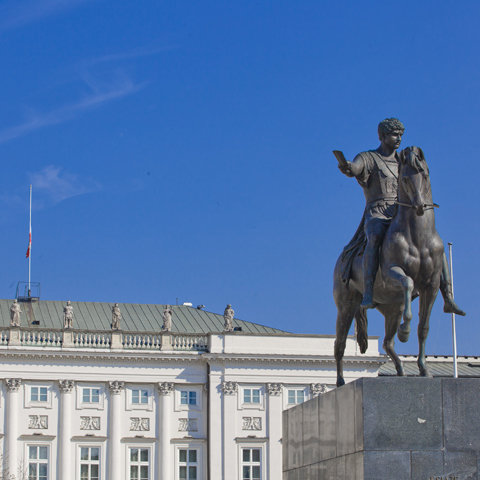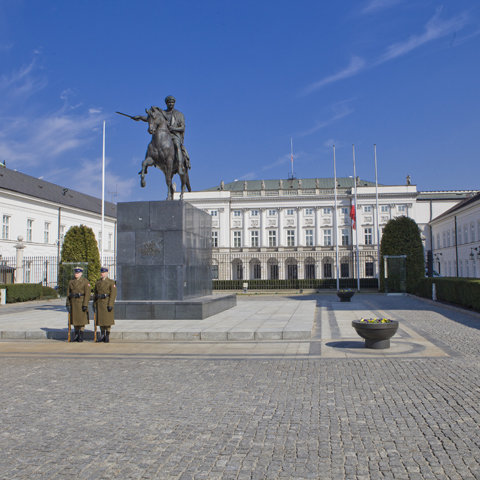Composers / Fryderyk Chopin / Places catalog
Viceroy's Palace
Jerzy S. Majewski writes: ‘The Kingdom of Poland purchased a palace on Krakowskie Przedmieście from the Radziwiłł family in 1818 with a view to installing there General Józef Zajączek, the Viceroy [hence the name Viceroy’s Palace] of the Kingdom. Senator Nikolay Novosiltsov, the Plenipotentiary Commissar of Tsar Alexander I at the Council of State of the Kingdom, was engaged to negotiate the sale’. At the time, Novosiltsov was one of three guardians of the minor princess Stefania Radziwiłł. It can be assumed that he brought particular pressure to bear in advocating the sale of the palace and that he was not acting selflessly in doing so. Piotr Aigner was entrusted with rebuilding the original Baroque edifice, and it is him we can thank for this imposing and ostentatious work of architecture, with its many classical features, pillars and half-columns, and its attic adorned with ten statues. Purchasing and rebuilding the palace cost more than 3.5 million zloty – an exorbitant sum at the time.
The residents of Warsaw looked askance at this outlay and the extravagant lifestyle of the new viceroy’s wife, who was celebrated for her beauty. “General Zajączek, the recently appointed Viceroy of the Kingdom, was greeted with scepticism’, Karolina Beylin claimed in Opowieści warszawskie [Warsaw tales]. “The little Warsaw street urchins, who tramped barefoot past the Krakowskie Przedmieście townhouses, would run outside Radziwiłł Palace, now beautifully rebuilt by Aigner and renamed the Viceroy’s Palace, singing a derisive song composed by a spiteful Warsaw:
Everyone who hears it wonders,
That hills that bred mice
For thousands of years
Now give us hares. [a pun on the name ‘Zajączek’ (Polish: little hare)]
Neither did the extravagant luxuries his wife allowed herself do anything to raise confidence in the Viceroy. […] In those days of widespread poverty, prodigious sums were spent on refined luxuries for the viceroy’s palace. For example, lingerie was sent to Paris by post-chaise to be washed, and extremely expensive bronze was brought in from abroad for the palace windows”.
The viceroy’s wife might have been controversial, but she definitely had her pluses. At the very least, her exceptional beauty is worth mentioning. This led to her being deemed a beautiful woman whose age was hard to guess, even as she advanced in years. The music critic and writer Ferdynand Hoesick assures us in his Warszawa. Luźne kartki z przeszłości syreniego rodu [Warsaw: loose leaves from the past of the mermaid city]: ‘She was an enthusiastic admirer of Chopin’s talent’. Hoesick goes on to stress: ‘She might have been fickle, but Mrs Zajączek had plenty of dignity and character. […] She not only inspired consideration and respect, but she still knew how to arouse love in her final years. She was never short of admirers. There is no chance that Chopin fell for the viceroy’s wife when he came to functions at the Zajączeks, but he tried to play as beautifully as he could whenever he played before her and her aged spouse. This followed from the very nature of the situation. One way or another, for a young person like Fryderyk, the son of a school teacher, being at the residence of the viceroy, the most important person in the country after Grand Duke Constantine, was an extraordinary honour’.
Before the young Chopin could even be presented to the viceroy and his wife, however, he had appeared at Radziwiłł Palace on 24 February 1818, so not long before the grand rebuilding described here. The then owner of the palace, Prince Karol “Panie Kochanku” Radziwiłł, had leased the building to Franciszek Ryx, who organised his ‘French’ theatre there.
It was at that French Theatre that Fryderyk Chopin made his first public appearance as a young boy in a concert organised by the Warsaw Charitable Society, run by Julian Ursyn Niemcewicz. As the event was publicly announced in a supplement to the ‘Gazeta Korespondenta Warszawskiego i Zagranicznego’ [Gazette of the Warsaw and foreign correspondent] on 21 February 1818, we know that Ms Vicini and Piotr Kaczyński played violin, Piotr’s brother Józef cello and Karol Arnold piano, and Jacques Brice and Louis Feuillide sang. Chopin’s performance of a piano concerto by Bohemian composer Vojtěch Jírovec (also known by his German name of Adalbert Gyrowetz) was greeted with thunderous applause. He must have gone home quite excited. He apparently thought that it was his new lacy collar that had aroused the admiration of the audience.
-

Monument to Prince Józef Poniatowski. Phot. Wademar Kielichowski.
-

Namiestnikowski Palace, present Presidential Palace. Phot. Wademar Kielichowski.
-

Namiestnikowski Palace, present Presidential Palace. Phot. Wademar Kielichowski.